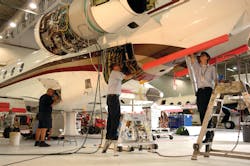Designing and Developing the Best in Class Business Aircraft
According to Gulfstream the “G650® flies faster, farther, and more comfortably than any other business aircraft in its class.” On Dec. 20, 2012, Gulfstream Aerospace Corp. delivered its first fully outfitted Gulfstream G650 aircraft. In the news releases, Larry Flynn, president, Gulfstream said that "We’re extremely proud of the work that’s been done by the G650 design, build, and supplier teams. This delivery represents the beginning of a new era in aircraft design and manufacturing in terms of quality, capabilities, reliability, parts availability, and maintenance activities.”
We asked Gulfstream Product Support’s vice president of East Coast Operations, Barry Russell to explain what was different about the design and build of the G650. “We used a different approach in the design phase, and new manufacturing technologies allowed us to build the G650 with more precision than previous models.
"Twenty-five years ago, the GIV was built from blueprints by our engineers and draftsmen. For the G650, we used 3-D modeling. We also used advanced machine technologies to build close tolerance composite skin panels and machined parts such as frames and bulkheads, all of which required very little fit and trim. The aircraft fits together quite nicely.
"As far as our outfitting processes, 25 years ago we used to fit and trim interior panels and furnishings, remove them from the aircraft, apply finishes, and then reinstall them. Today, we have a one-time install after everything is done outside the aircraft. As you can imagine, that reduces your cycle time in final phase. Additionally, we install the G650 interior with just a few tools.
"Gulfstream decided that from a product support perspective we would embed teams at the start of the design phase. We really wanted to make a difference and do something we had never done before. So we took several 30-years-plus Gulfstream technicians and started looking at some of our past models and how, from a maintenance standpoint, we could make them better. We set out with some stringent goals for things like LRU removals, inspections, and operational checks. As always at Gulfstream, our first thoughts are safety and quality, but we also wanted to build in availability. Working with the engineering and design teams, we added a lot of input in these areas. It was truly a collaborative effort.
"Another interesting aspect was the use of 3-D model manikins that reflected the average size of a technician and the actual tools they use for a given task. This allowed us to look at the space technicians would work in from a space constraint and ergonomic standpoint. Using this technology, we were able to see how the virtual technician and their tools would perform at a specific point in a defined space. Consequently, we were able to build a maintenance friendly and reliable aircraft."
The Gulfstream G650 recently set a westbound around-the-world speed world. When asked if these manufacturing processes and new technology made a difference? That record is impressive says Russell, but being the former vice president of Customer Support he also emphasizes that “after the first year of operations the G650 has a 99.6 percent dispatch reliability.”
About the Author
Charles Chandler
Charles Chandler began his aviation career as a junior mechanic for American Airlines and retired after 27 years of service. Charles Chandler has a Master’s of Science degree in adult and occupational education with a major in human resources development.

